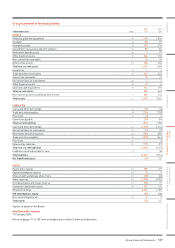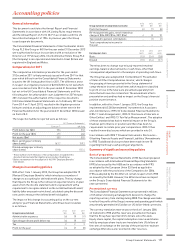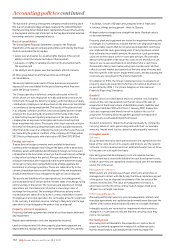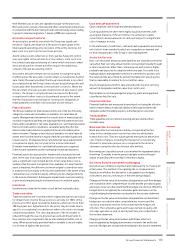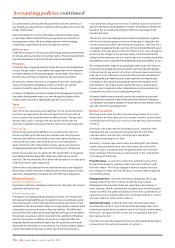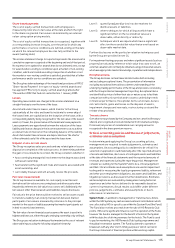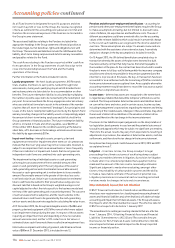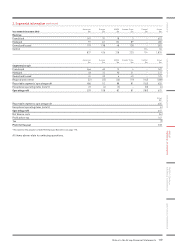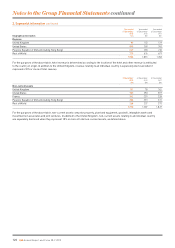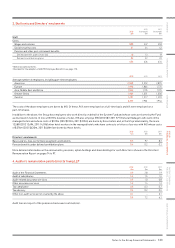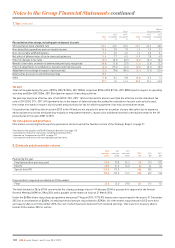Holiday Inn 2013 Annual Report Download - page 118
Download and view the complete annual report
Please find page 118 of the 2013 Holiday Inn annual report below. You can navigate through the pages in the report by either clicking on the pages listed below, or by using the keyword search tool below to find specific information within the annual report.
As all Fund income is designated for specific purposes and does
not result in a profit or loss for the Group, the revenue recognition
criteria as outlined in the accounting policy above are not met and
therefore the income and expenses of the Fund are not included in
the Group income statement.
The assets and liabilities relating to the Fund are included in the
appropriate headings in the Group statement of financial position as
the related legal, but not beneficial, rights and obligations rest with
the Group. These assets and liabilities include the IHG Rewards Club
liability, short-term timing surpluses and deficits and any receivables
and payables related to the Fund.
The cash flows relating to the Fund are reported within ‘cash flow
from operations’ in the Group statement of cash flows due to the
close interrelationship between the Fund and the trading
operations of the Group.
Further information on the Fund is included in note 34.
Loyalty programme – the hotel loyalty programme, IHG Rewards
Club, enables members to earn points, funded through hotel
assessments, during each qualifying stay at an IHG branded hotel
and redeem points at a later date for free accommodation or other
benefits. The future redemption liability is calculated by multiplying
the number of points expected to be redeemed by the redemption cost
per point. On an annual basis the Group engages an external actuary
who uses statistical formulas to assist in the estimate of the number
of points that will never be redeemed (‘breakage’). Actuarial gains and
losses on the future redemption liability are borne by the System Fund
and any resulting changes in the liability would correspondingly adjust
the amount of short-term timing surpluses and deficits held in the
Group statement of financial position. The future redemption liability,
which is included in trade and other payables, was $649m at
31 December 2013. Based on the conditions existing at the balance
sheet date, a 5% decrease in the breakage estimate would increase
this liability by approximately $31m.
Impairment testing – intangible assets, property, plant and
equipment are tested for impairment when events or circumstances
indicate that their carrying value may not be recoverable. Goodwill is
subject to an impairment test on an annual basis or more frequently
if there are indicators of impairment. Assets that do not generate
independent cash flows are combined into cash-generating units.
The impairment testing of individual assets or cash-generating
units requires an assessment of the recoverable amount of the
asset or cash-generating unit. If the carrying value of the asset or
cash-generating unit exceeds its estimated recoverable amount,
the asset or cash-generating unit is written down to its recoverable
amount. Recoverable amount is the greater of fair value less costs
to sell and value in use. Value in use is assessed based on estimated
future cash flows discounted to their present value using a pre-tax
discount rate that is based on the Group’s weighted average cost of
capital adjusted to reflect the risks specific to the business model and
territory of the cash-generating unit or asset being tested. The outcome
of such an assessment is subjective, and the result sensitive to the
assumed future cash flows to be generated by the cash-generating
units or assets and discount rates applied in calculating the value in use.
At 31 December 2013, the Group had intangible assets of $438m and
property, plant and equipment of $1,169m, none of which were subject
to an impairment charge during the year. In respect of those assets
requiring an impairment test and depending on how recoverable
amount was assessed, neither a 10% reduction in fair value or
estimated future cash flows would have resulted in an impairment loss.
Information on impairment testing of goodwill, which had a net book
value of $80m at 31 December 2013, is included in note 12.
Pensions and other post-employment benefit plans – accounting for
pensions and other post-employment benefit plans requires the Group
to make assumptions including, but not limited to, discount rates,
rates of inflation, life expectancies and healthcare costs. The use of
different assumptions could have a material effect on the accounting
values of the relevant liabilities which could result in a material change
to the cost of such liabilities as recognised in the income statement
over time. These assumptions are subject to annual review and are
determined with the assistance of an external actuary. A sensitivity
analysis to changes in the key assumptions is included in note 26.
On 15 August 2013, the UK defined benefit plan completed a buy-in
transaction whereby the assets of the plan were invested in a bulk
insurance annuity contract that fully insures the benefits payable to
the members of the plan. As the contract has been structured to enable
the plan to move to full buy-out (following which the insurance company
would become directly responsible for the pension payments) and the
intention is to proceed on this basis, the buy-in transaction has been
accounted for as a settlement with the loss arising of $147m recorded in
the income statement as an exceptional item. An acceptable alternative
accounting treatment would have been to record the loss as an actuarial
loss in other comprehensive income.
Income taxes – deferred tax assets are recognised to the extent that it
is regarded as probable that deductible temporary differences can be
realised. The Group estimates deferred tax assets and liabilities based
on current tax laws and rates, and in certain cases, business plans,
including management’s expectations regarding the manner and timing
of recovery of the related assets. Changes in these estimates may affect
the amount of deferred tax liabilities or the valuation of deferred tax
assets and therefore the tax charge in the income statement.
Provisions for tax liabilities require judgements on the interpretation of
tax legislation, developments in case law and the potential outcomes of
tax audits and appeals which may be subject to significant uncertainty.
Therefore the actual results may vary from expectations resulting in
adjustments to provisions, the valuation of deferred tax assets, cash tax
settlements, and therefore the tax charge in the income statement.
Exceptional tax charges and credits have arisen in 2013, 2012 and 2011
as explained in note 7.
Litigation – from time to time, the Group is subject to legal
proceedings the ultimate outcome of each being always subject
to many uncertainties inherent in litigation. A provision for litigation
is made when it is considered probable that a payment will be
made and the amount of the loss can be reasonably estimated.
Significant judgment is made when evaluating, amongst other
factors, the probability of unfavourable outcome and the ability
to make a reasonable estimate of the amount of potential loss.
Litigation provisions are reviewed at each accounting period and
revisions made for changes in facts and circumstances.
New standards issued but not effective
IFRS 9 ‘Financial Instruments: Classification and Measurement’
introduces new requirements for classifying and measuring financial
assets and financial liabilities and, when finalised, willaddress hedge
accounting and impairment of financial assets. The Group will assess
the impacts when the final standard is issued. The effective date for
IFRS 9 is not expected to be before 1January 2017.
The amendments to existing accounting standards that are effective
from 1 January 2014, ‘Offsetting Financial Assets and Financial
Liabilities’ (Amendments to IAS 32) and ‘Recoverable Amount
Disclosures for Non-Financial Assets’ (Amendments to IAS 36),
are not expected to have a material impact on the Group’s reported
income or financial position.
116 IHG Annual Report and Form 20-F 2013
Accounting policies continued





